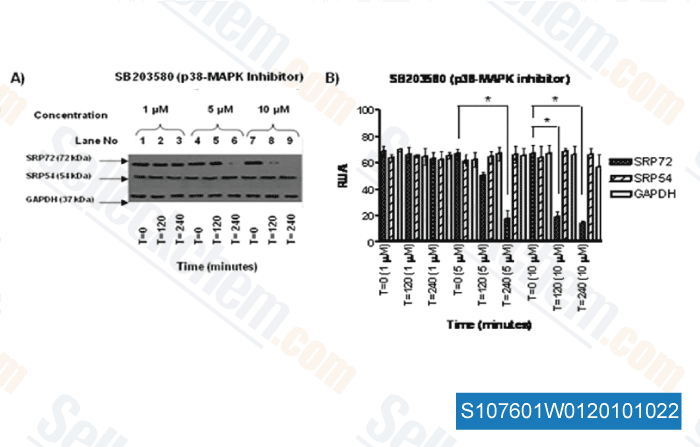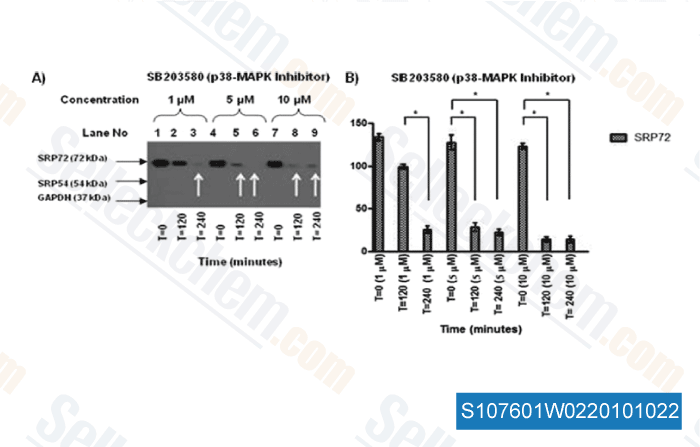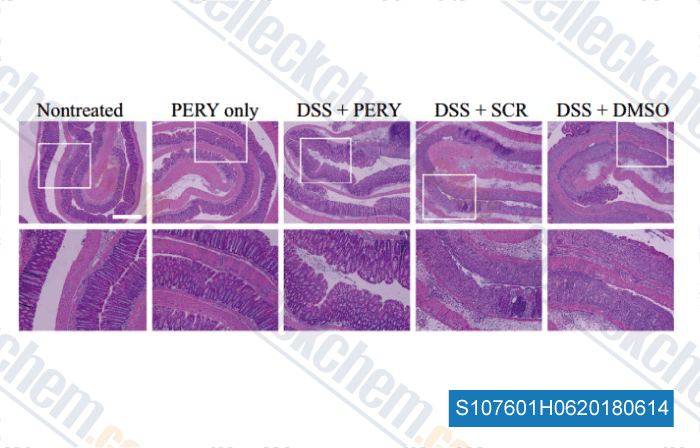|
Toll Free: (877) 796-6397 -- USA and Canada only -- |
Fax: +1-832-582-8590 Orders: +1-832-582-8158 |
Tech Support: +1-832-582-8158 Ext:3 Please provide your Order Number in the email. |
Technical Data
| Formula | C21H16FN3OS |
|||
| Molecular Weight | 377.43 | CAS No. | 152121-47-6 | |
| Solubility (25°C)* | In vitro | DMSO | 35 mg/mL (92.73 mM) | |
| Water | Insoluble | |||
| Ethanol | Insoluble | |||
|
* <1 mg/ml means slightly soluble or insoluble. * Please note that Selleck tests the solubility of all compounds in-house, and the actual solubility may differ slightly from published values. This is normal and is due to slight batch-to-batch variations. * Room temperature shipping (Stability testing shows this product can be shipped without any cooling measures.) |
||||
Preparing Stock Solutions
Biological Activity
| Description | Adezmapimod (SB203580, RWJ 64809, PB 203580) is a p38 MAPK inhibitor with IC50 of 0.3-0.5 μM in THP-1 cells, 10-fold less sensitive to SAPK3(106T) and SAPK4(106T) and blocks PKB phosphorylation with IC50 of 3-5 μM. SB203580 induces mitophagy and autophagy. | ||||
|---|---|---|---|---|---|
| Targets |
|
||||
| In vitro | SB203580 inhibits the IL-2-induced proliferation of primary human T cells, murine CT6 T cells, or BAF F7 B cells with an IC50 of 3–5 μm. SB203580 also inhibits IL-2-induced p70S6 kinase activation, although the concentration required is slightly higher with an IC50 above 10 μm. SB203580 also inhibits the activity of PDK1 in a dose-dependent manner with an IC50 in the 3–10 μm range. [1] SB203580 inhibits p38-MAPK stimulation of MAPKAPK2 with an IC50 of approximately 0.07 μM, whereas inhibits total SAPK/JNK activity with an IC50 of 3–10 μM. SB203580 at higher concentrations activates the ERK pathway, which subsequently enhances NF-κB transcriptional activity. [2] SB203580 induces autophagy in human hepatocellular carcinoma (HCC) cells. [3] |
||||
| In vivo | SB203580 protects pig myocardium against ischemic injury in an in vivo model. [4]SB203580 is effective to prevent and treat the disease in MRL/lpr mice model of Systemic lupus erythematosus (SLE). [5] |
||||
| Features | First reported p38 inhibitor. |
Protocol (from reference)
| Kinase Assay: |
|
|---|---|
| Cell Assay: |
|
| Animal Study: |
|
References
Customer Product Validation

-
Data from [J Biol Chem, 2010, 285, 32824-32833]

-
Data from [J Biol Chem, 2010, 285, 32824–32833]

-
Data from [J Biol Chem, 2010, 285, 32824–32833]

-
Data from [Data independently produced by , , Science, 2018, 11(525), doi: 10.1126/scisignal.aao3428]
Selleck's Adezmapimod (SB203580) has been cited by 1002 publications
| Oncogenic RAS induces a distinctive form of non-canonical autophagy mediated by the P38-ULK1-PI4KB axis [ Cell Res, 2025, 10.1038/s41422-025-01085-9] | PubMed: 40055523 |
| First-in-class ultralong-target-residence-time p38α inhibitors as a mitosis-targeted therapy for colorectal cancer [ Nat Cancer, 2025, 6(2):259-277] | PubMed: 39820127 |
| A novel human specific lncRNA MEK6-AS1 regulates adipogenesis and fatty acid biosynthesis by stabilizing MEK6 mRNA [ J Biomed Sci, 2025, 32(1):6] | PubMed: 39773638 |
| Identification of chemical inhibitors targeting long noncoding RNA through gene signature-based high throughput screening [ Int J Biol Macromol, 2025, 292:139119] | PubMed: 39722392 |
| Molecular control of PDPNhi macrophage subset induction by ADAP as a host defense in sepsis [ JCI Insight, 2025, e186456] | PubMed: 39903516 |
| Mechanoreceptor Piezo1 channel-mediated interleukin expression in conjunctival epithelial cells: Linking mechanical stress to ocular inflammation [ Ocul Surf, 2025, 36:56-68] | PubMed: 39778715 |
| Conditional knockdown of hepatic PCSK9 ameliorates high-fat diet-induced liver inflammation in mice [ Front Pharmacol, 2025, 16:1528250] | PubMed: 39963241 |
| Sotorasib resistance triggers epithelial-mesenchymal transition and activates AKT and P38-mediated signaling [ Front Mol Biosci, 2025, 12:1537523] | PubMed: 39950162 |
| KGF impedes TRIM21-enhanced stabilization of keratin 10 mediating differentiation in hypopharyngeal cancer [ Cell Signal, 2025, 127:111614] | PubMed: 39848455 |
| GH inhibits ALV-J replication and restricts cell cycle by activating PI3K/Akt signaling pathway [ Poult Sci, 2025, 104(1):104514] | PubMed: 39586129 |
RETURN POLICY
Selleck Chemical’s Unconditional Return Policy ensures a smooth online shopping experience for our customers. If you are in any way unsatisfied with your purchase, you may return any item(s) within 7 days of receiving it. In the event of product quality issues, either protocol related or product related problems, you may return any item(s) within 365 days from the original purchase date. Please follow the instructions below when returning products.
SHIPPING AND STORAGE
Selleck products are transported at room temperature. If you receive the product at room temperature, please rest assured, the Selleck Quality Inspection Department has conducted experiments to verify that the normal temperature placement of one month will not affect the biological activity of powder products. After collecting, please store the product according to the requirements described in the datasheet. Most Selleck products are stable under the recommended conditions.
NOT FOR HUMAN, VETERINARY DIAGNOSTIC OR THERAPEUTIC USE.
